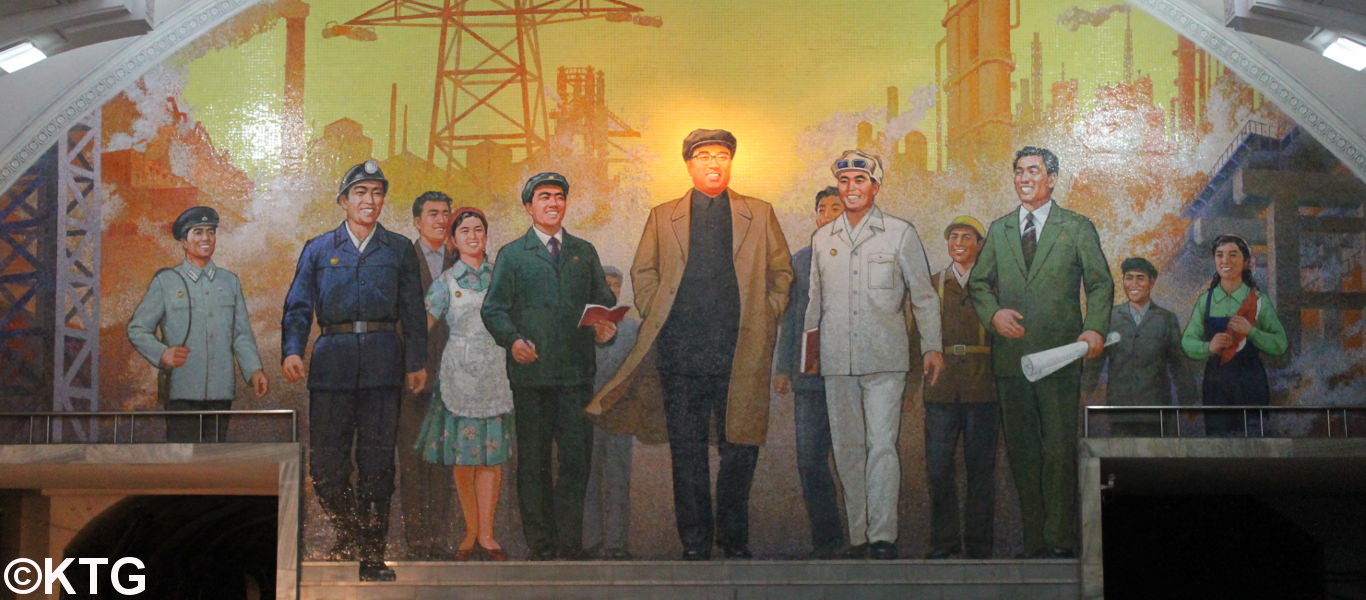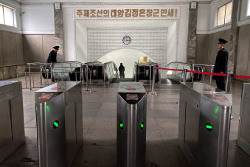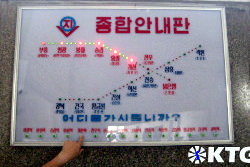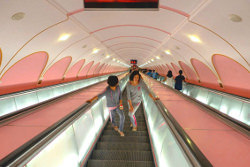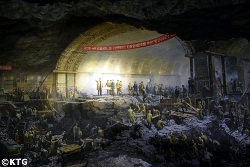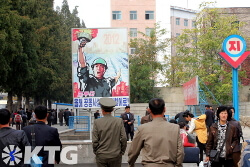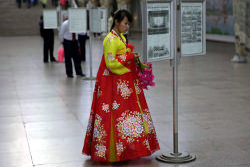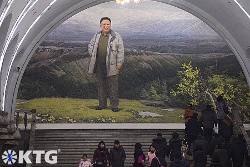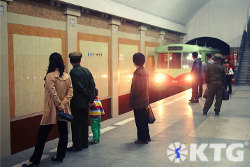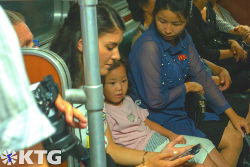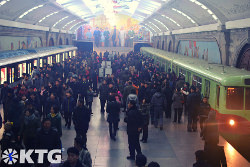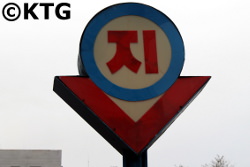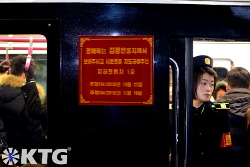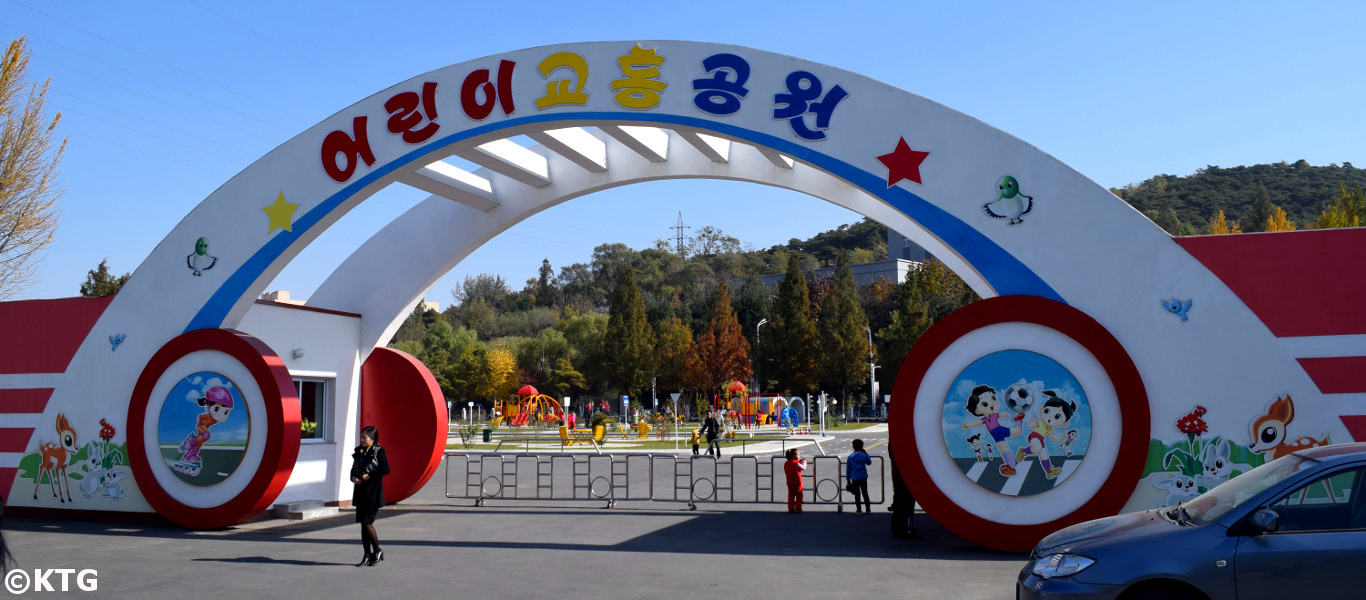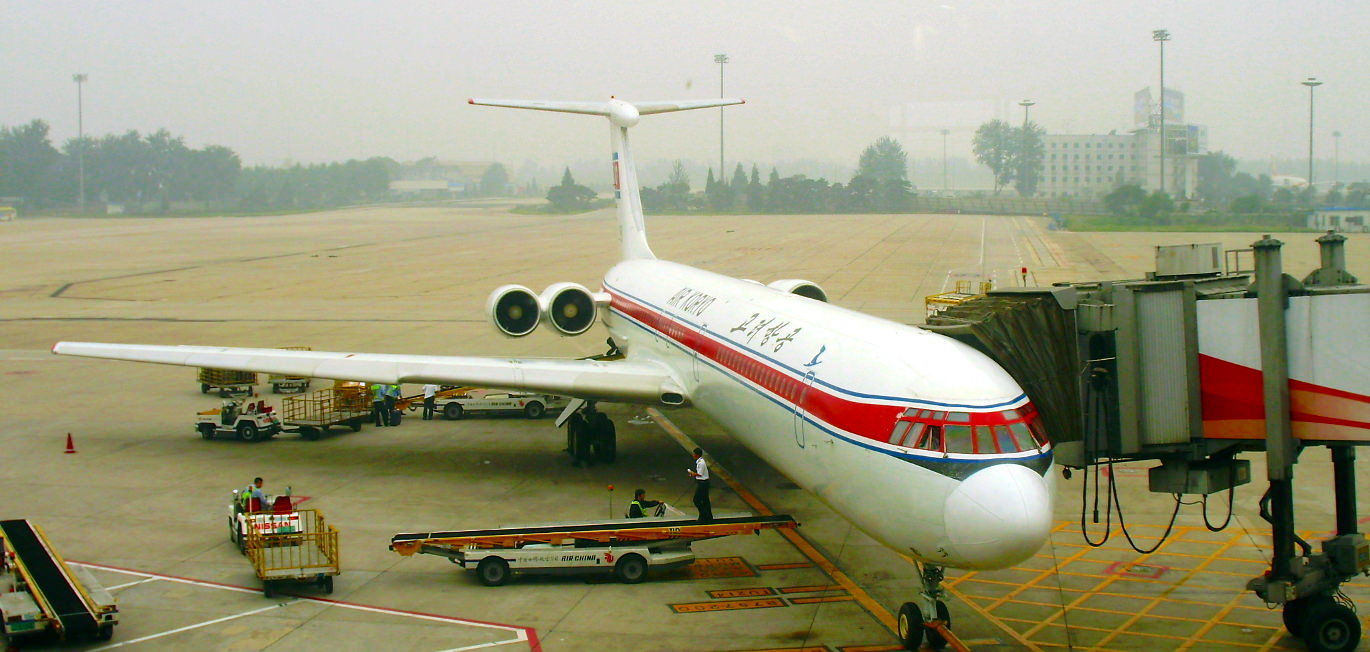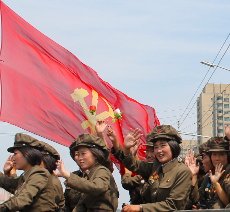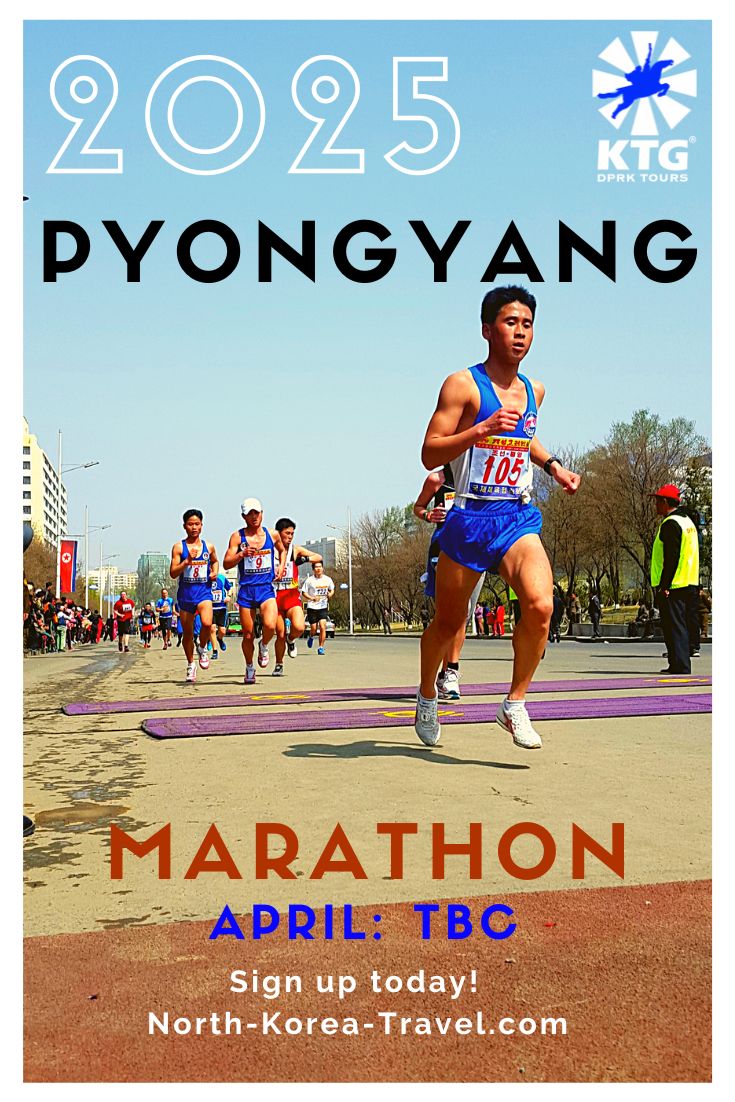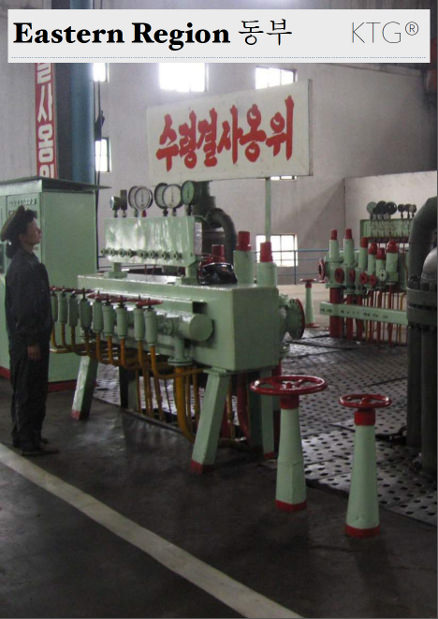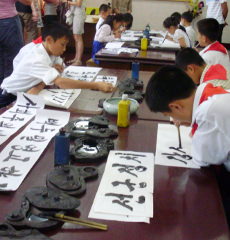The Pyongyang Metro | 평양 지하철도
German Graffiti and an Extensive Art Network 100 Metres Under Ground
Introduction
The Pyongyang Metro can boast having some of the most impressive underground stations in the world.
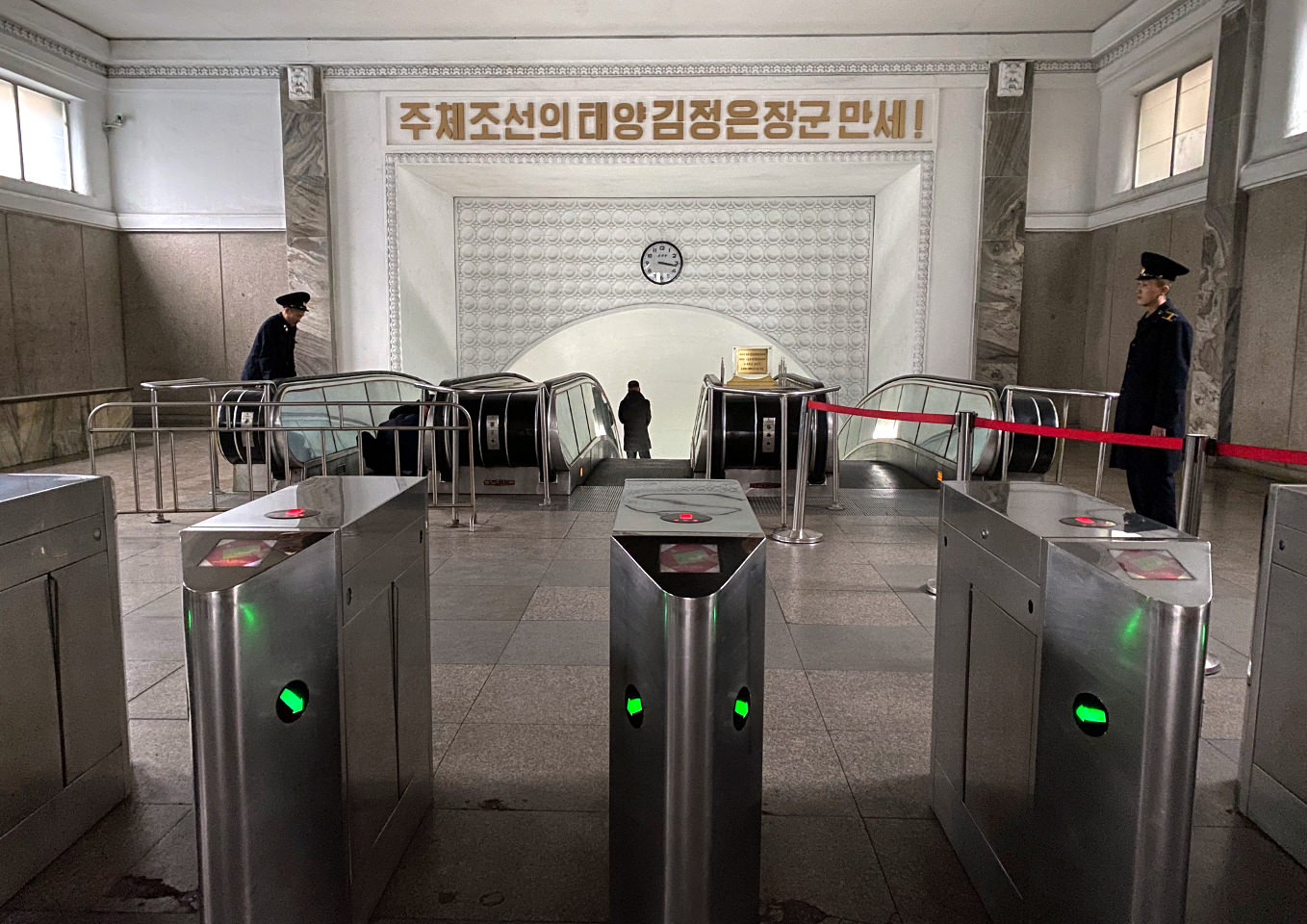
Enormous mosaic walls portraying national achievements, chandeliers, tunnels going down on an average of 100 metres (indeed, some tunnels go even deeper down) and interior wooden decorated dim lit wagons with portraits of the Leaders Kim Il Sung and Kim Jong Il, will all more than likely make taking the underground in Pyongyang somewhat different to what one may be used to.
Network
The North Korean capital's metro consists of two lines; The Chollima Line which goes from north to south and the Hyoksin Line which goes from east to west.
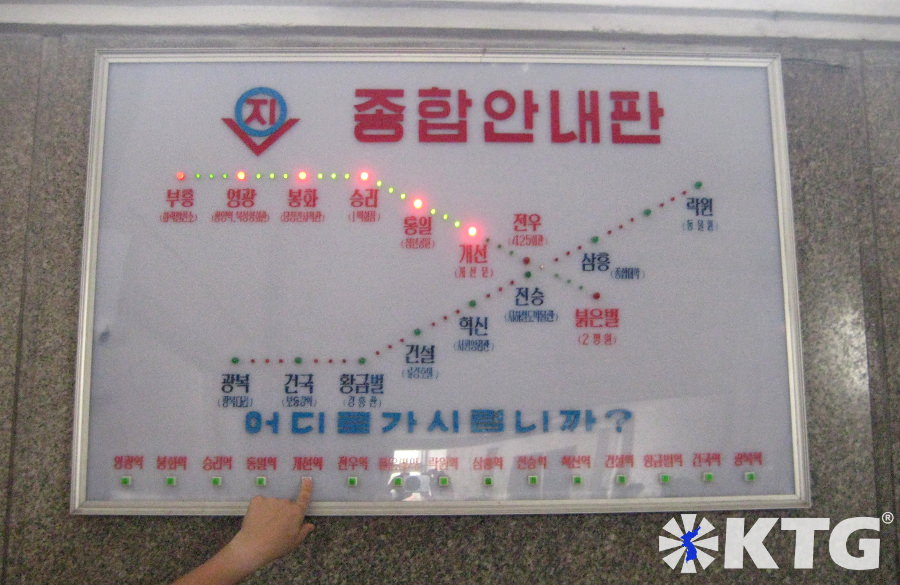
Not sure where you're going? This interactive map will be of help.
Both lines are on the west side of Pyongyang. There is no metro on the eastern side of the Taedong River.
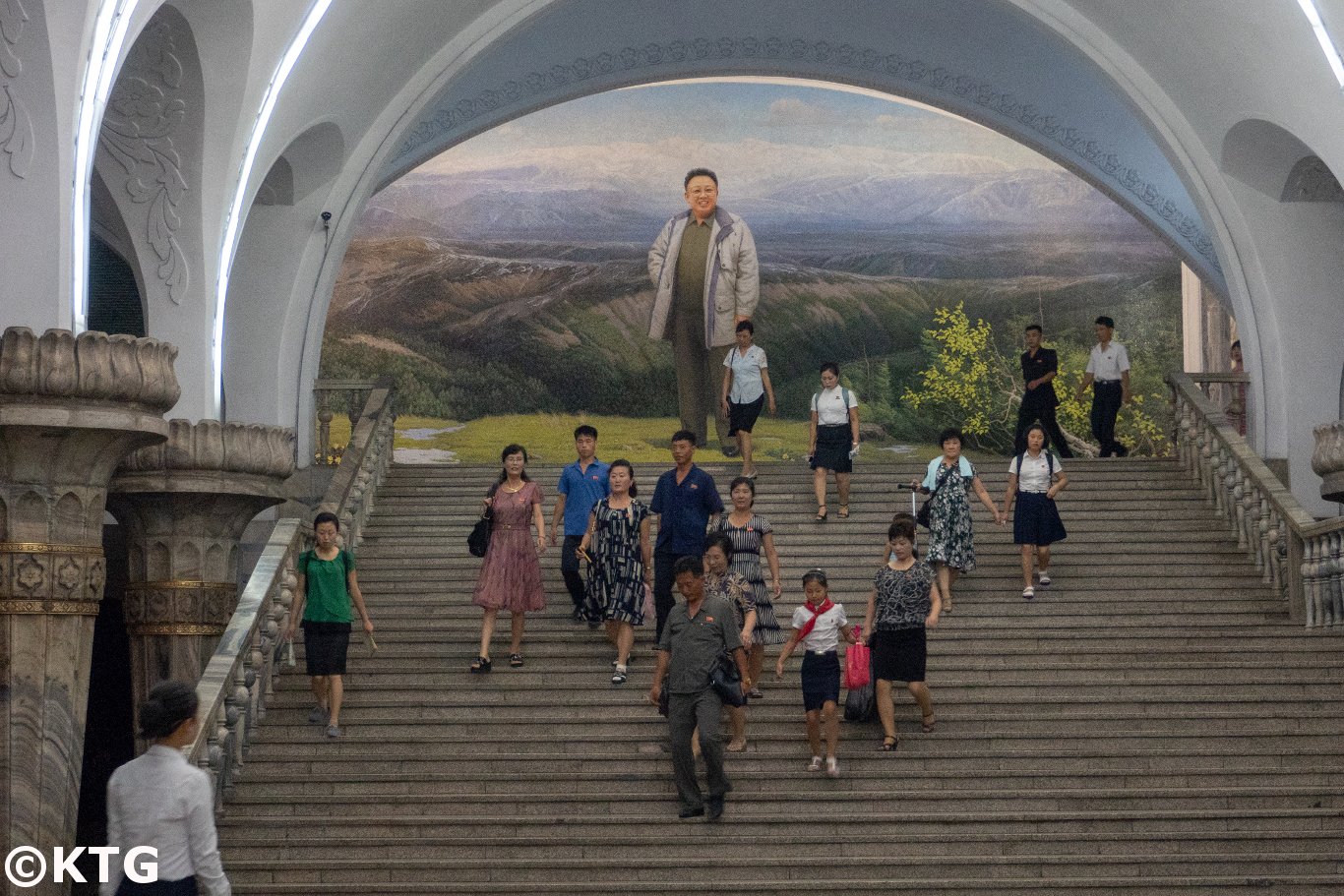
There is a total of 16 public stops and both lines intersect at the Jonsung (War Victory) and Jonu (Comrades in Arms) stations.
We have been arranging extended Pyongyang Metro rides for a few years now. It is possible for us to arrange an extensive metro ride including all but two stops of both lines for any subway enthusiast but for our group tours our rides will include going through 5 to 6 stations.
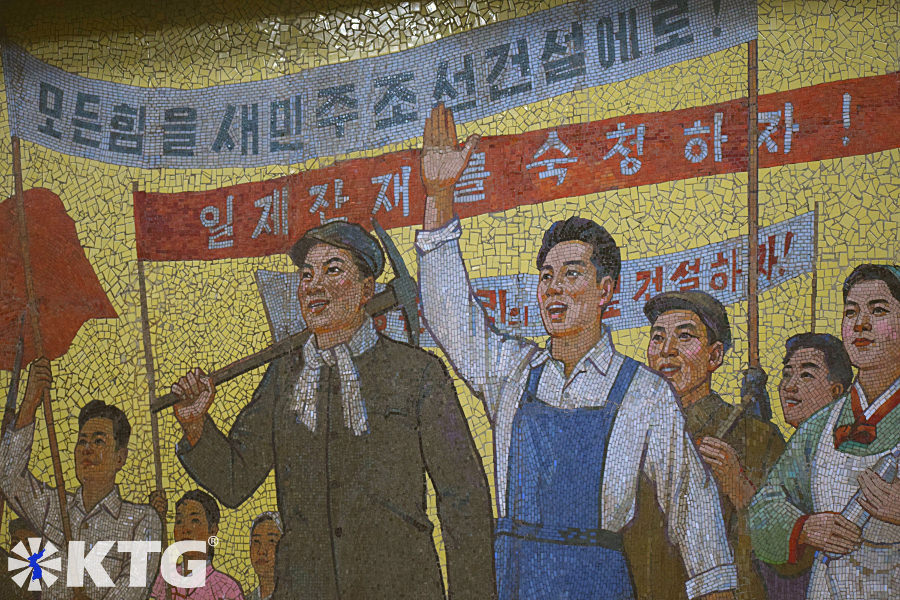
If you would like to explore all the public stations we can arrange this on a private tour or private extension.
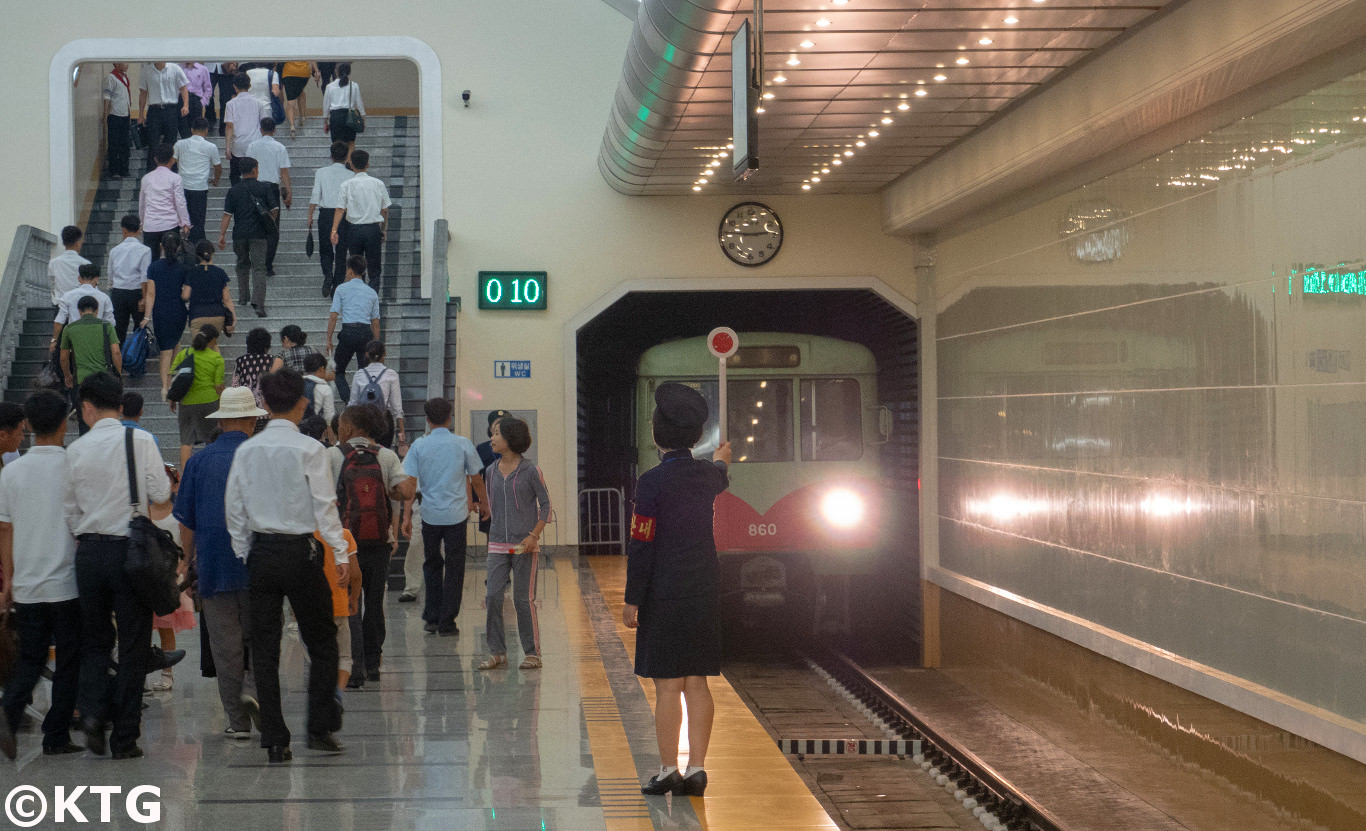
Depth
The Pyongyang metro has an average depth of 100 metres, some stops are 110 metres underground. This makes it one of the deepest underground systems in the world.
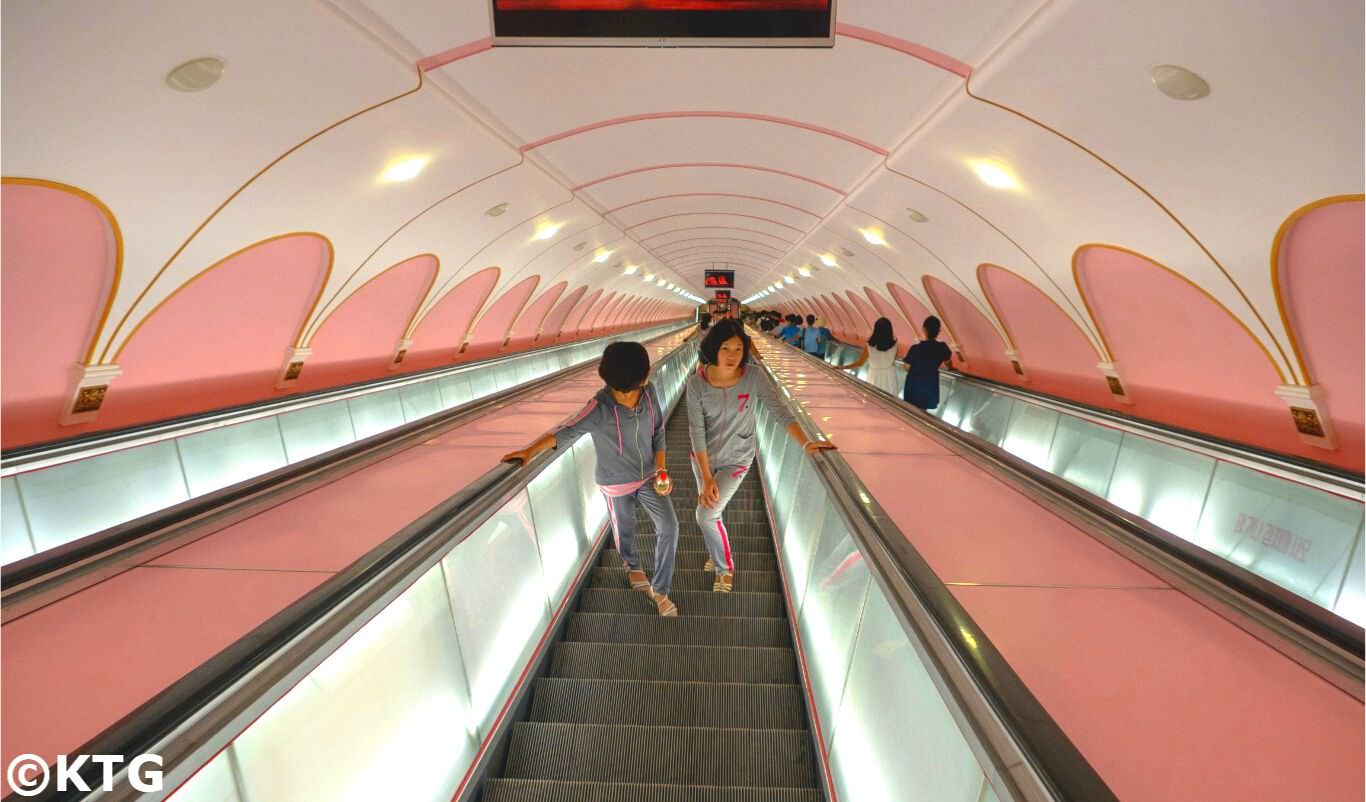
Taking the escalator either way, on what seems to be an endless journey is always impressive.
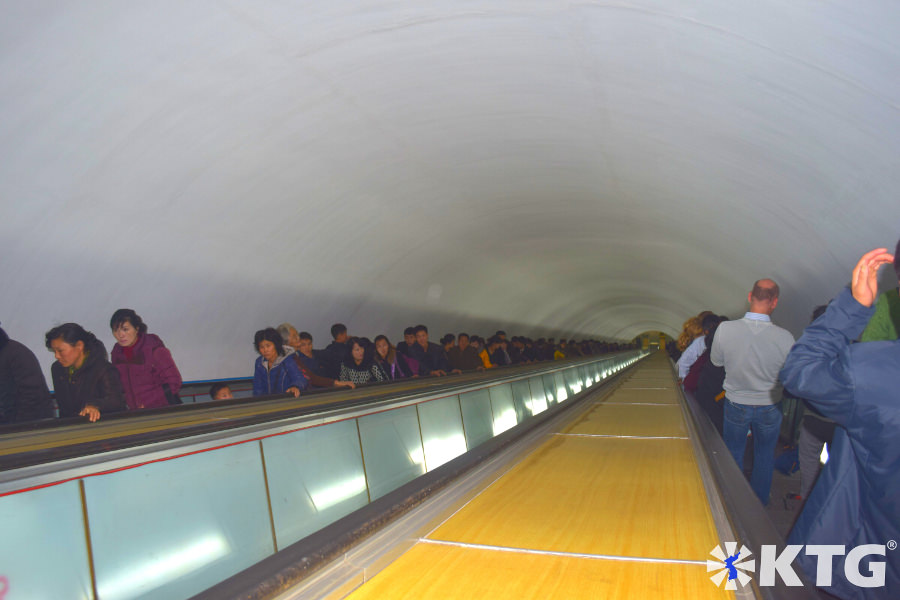
It also means that the metro is cool in summer and warm in winter. With an average temperature of 20°C (68°F) all year round, it is always a great feeling to go to a metro station in the capital’s scorching summers and freezing winters.
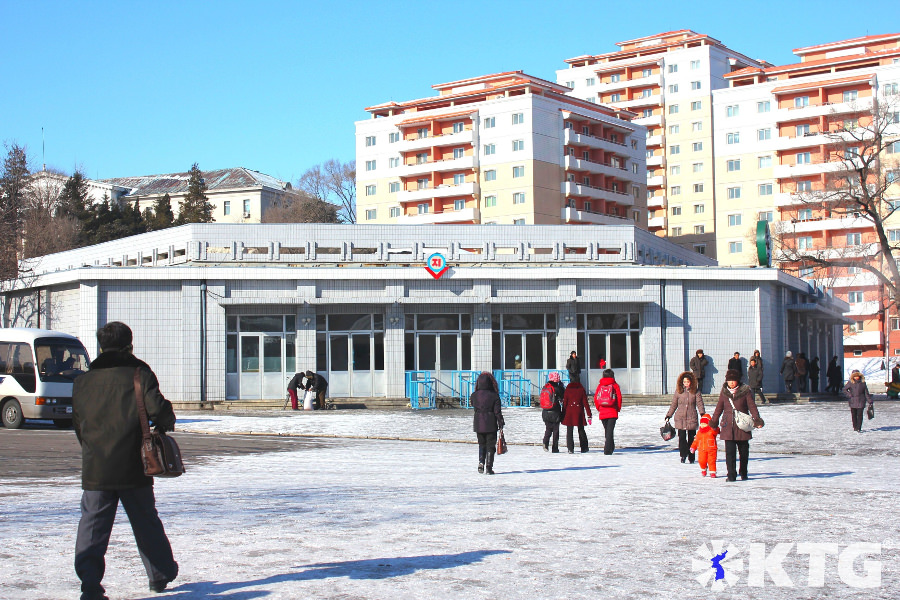
Winters are bitterly cold in Pyongyang and taking the metro is always a warm, pleasant break
Being so deep, the metro can also function as a bunker in case of military conflict as was the case with the London underground in WWII.
History
In 1968 construction on Chollima line. Chollima is the mythical winged horse used to inspire the rapid reconstruction of the DPRK after the Chollima Korean War. In 1973 it was opened to the public for use.
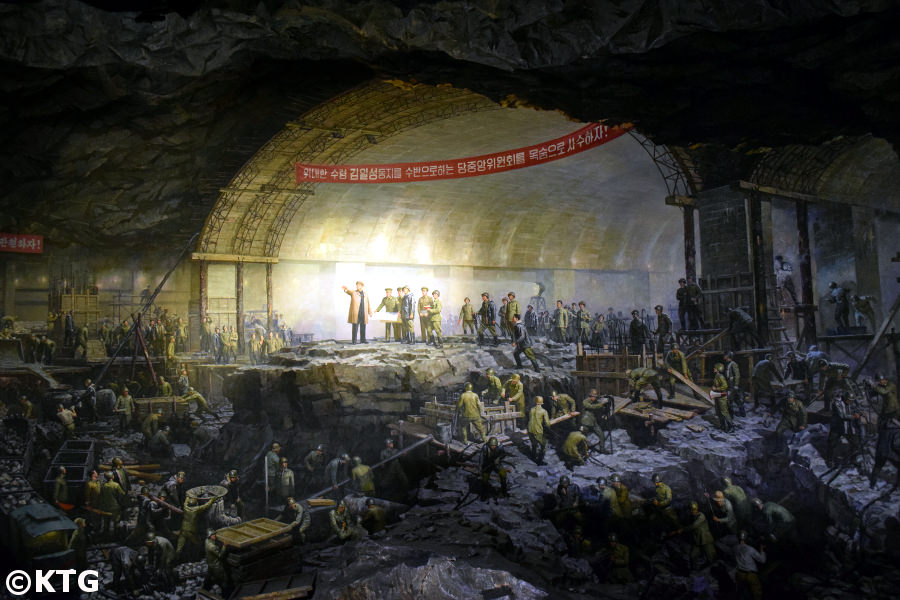
Mural inside the Pyongyang Metro Museum showing President Kim Il Sung during the construction of the Pyongyang Metro. Unfortunately there are just a few places inside the museum where are allowed to take pictures.
In the early 1970s construction began on Hyoksin line 2 and was opened in 1975 to the public.
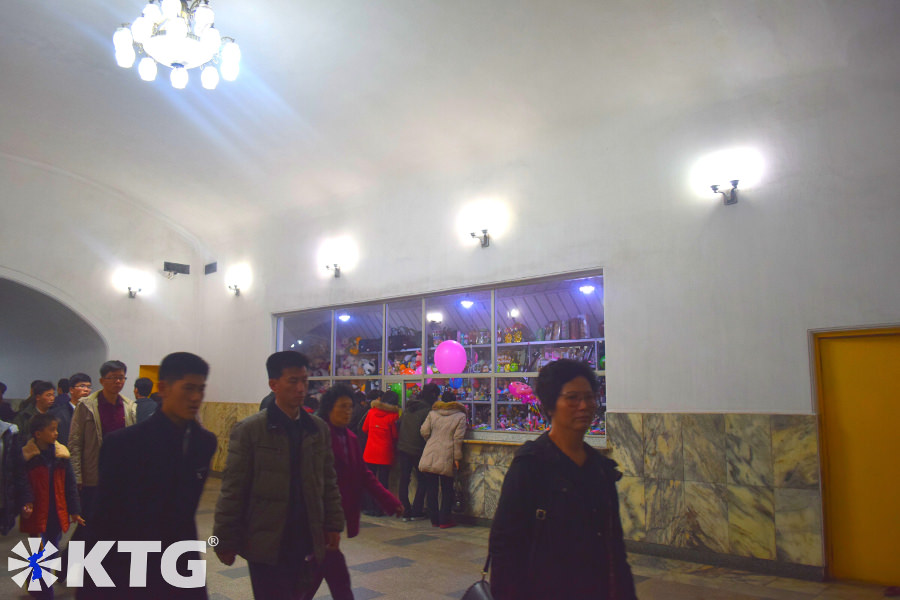
Shop inside one of the metro stations
Two of the most grandiose stations, and the only two tourists were able to see until 2010, Puhung (Reconstruction) and Yongwang (Glory) were built in 1987.
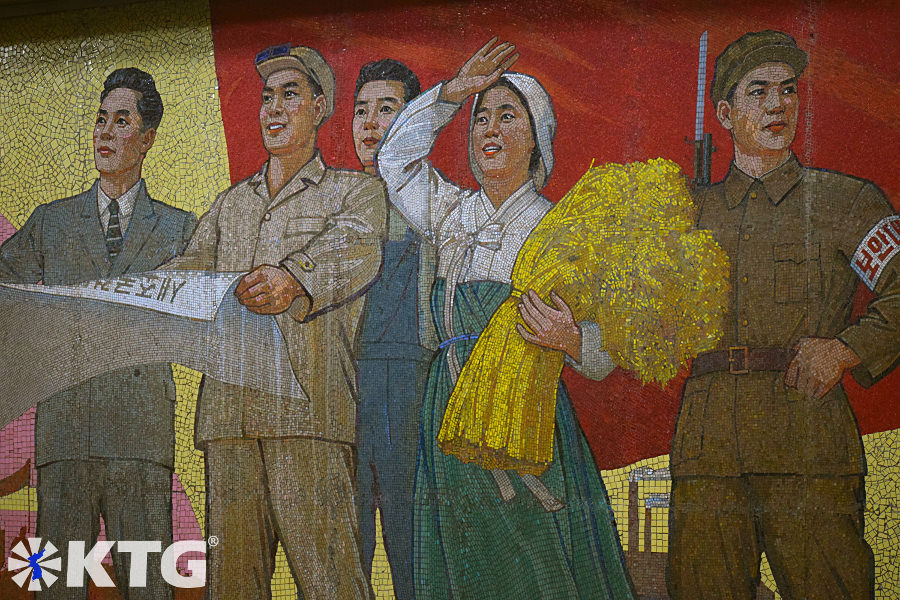
There is, in fact, a museum dedicated to the history of the Pyongyang metro. It is located by Ryomyong New Street.
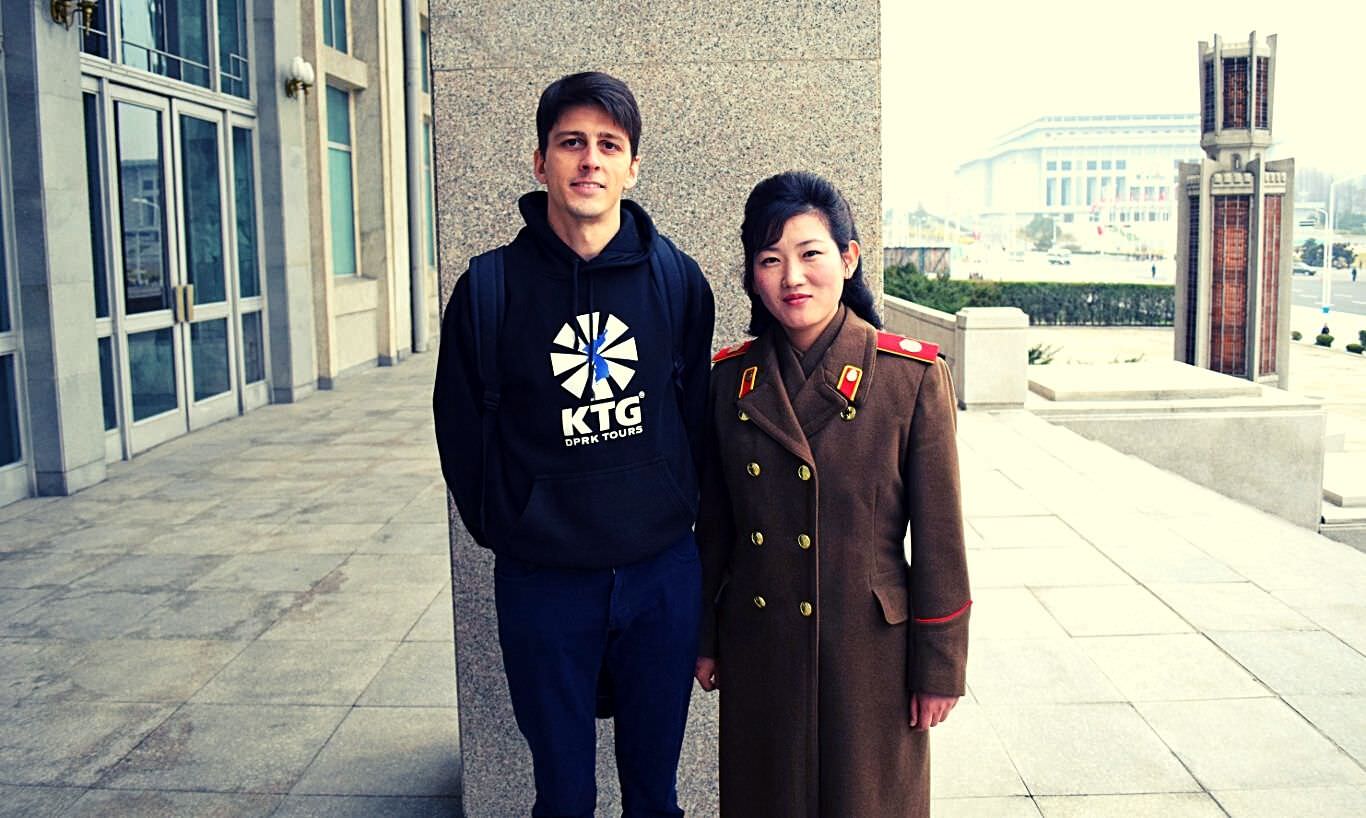
Rayco of KTG posing with the local guide at the Pyongyang Metro Museum
Users
It is estimated that at least 300,000 people use the Pyongyang metro everyday. On national holidays this can reach up to 700,000 people.
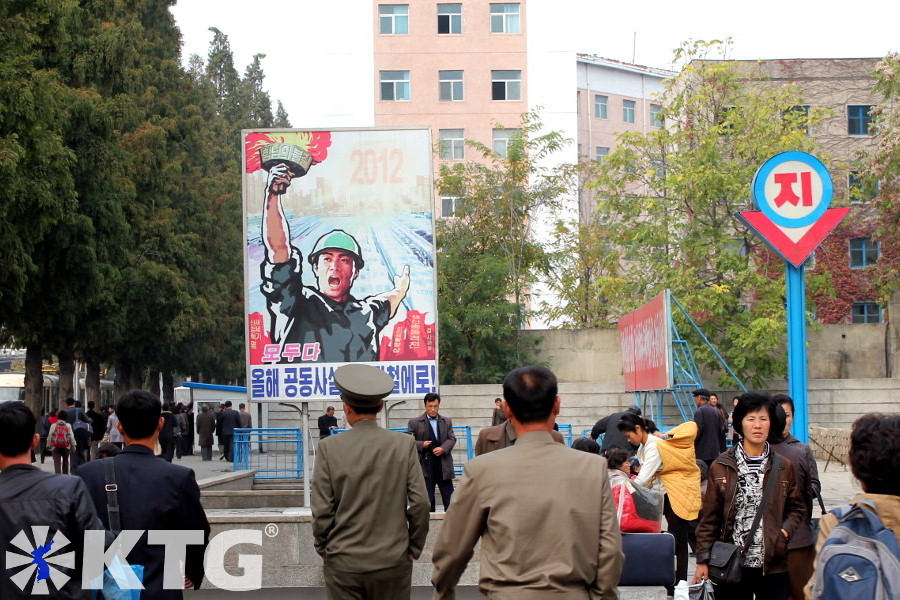
Spot the metro sign(지)?
Price
Rides cost 5 Korean Won, no matter your journey's distance, that is less than a US cent, making it the cheapest metro in the world. Moreover, this price has not changed since the metro was initially opened. We used to purchase paper tickets but now swipe cards are used.
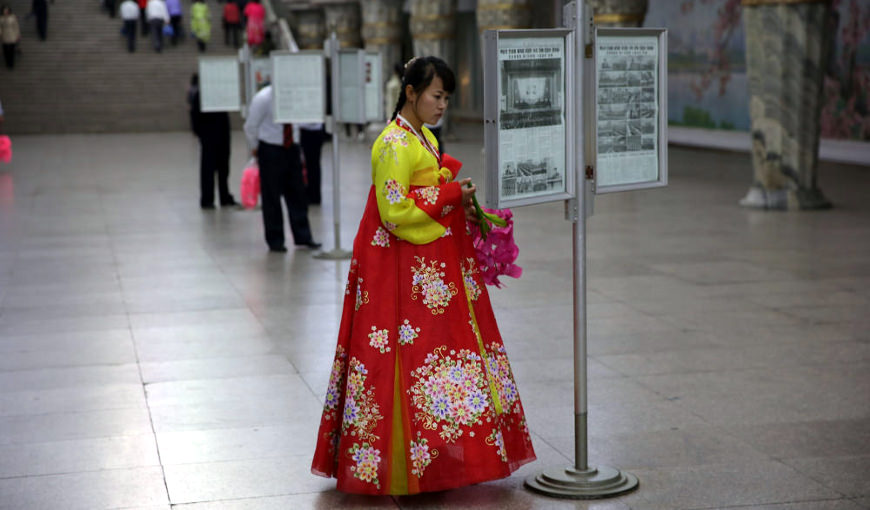
Lady in Korean traditional dress reading the newspaper at a metro station
Names
The stations have names core to the DPRK. Names such as Kaeson (Triumph), Sungri (Victory), Tongil (Unification), Yonggwang (Glory), Konguk (Founding of the Country) reflect on achievements made by the DPRK since its liberation from Japan and the country's founding.
Each station is decorated according to the theme of its name. For instance, Kaeson station, which commemorates the liberation from Japan, has a bronze statue of President Kim Il Sung giving his triumphal speech in 1945 after the Japanese were defeated. Mosaic murals show President Kim Il Sung giving his triumphal speech.
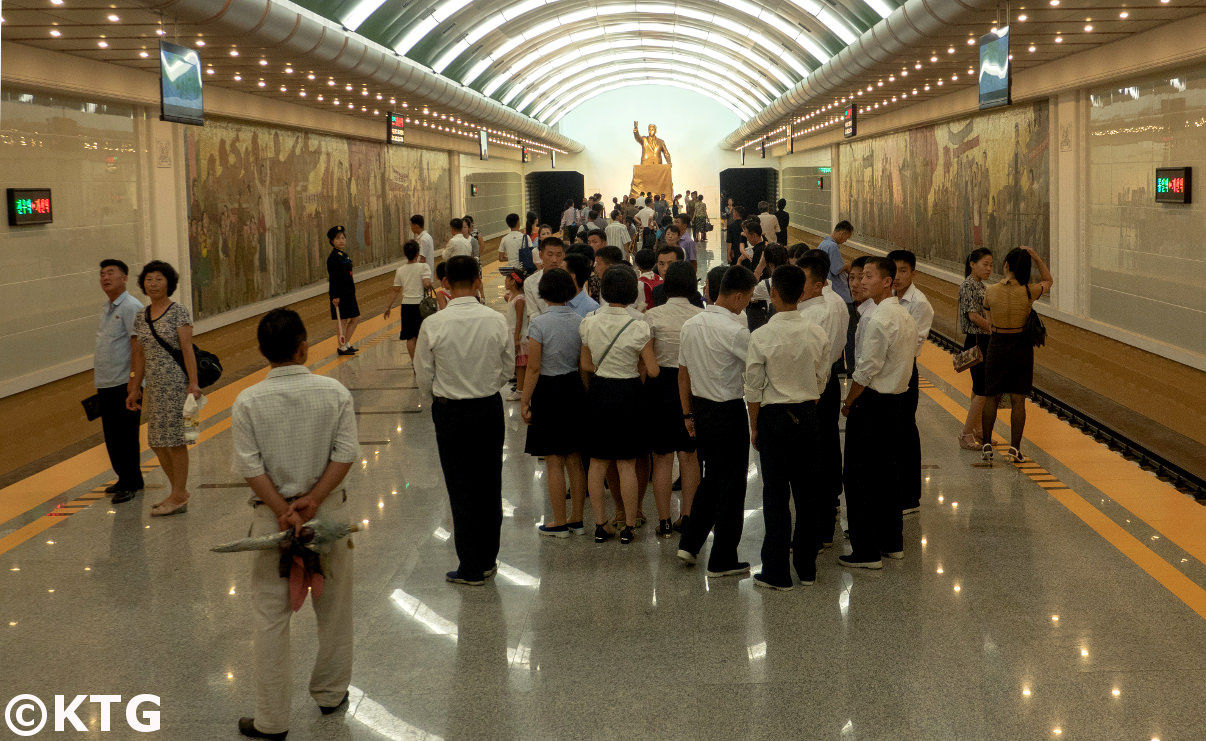
Students at Kaeson (Triumph) station
At Yonggwang (Glory) station, colourful, lavish chandeliers represent fireworks used to celebrate victories. Then intricately detailed mosaics portray east Pyongyang on one side of the platform and west Pyongyang on the other.
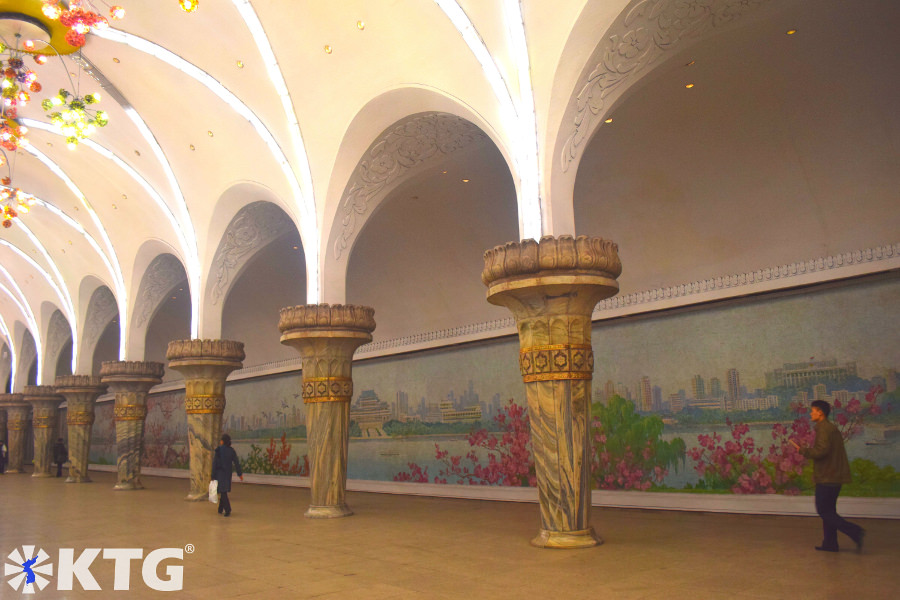
Can you spot the Grand People's House?
Puhung (Reconstruction) station has a beautiful mosaic of President Kim Il Sung with workers, representing the reconstruction of the DPRK after the Korean War.
Is the Pyongyang Metro Fake?
We have been asked by many travellers over the years if the Pyongyang Metro was a show with only two stops, with the people seen there being actors, etc.
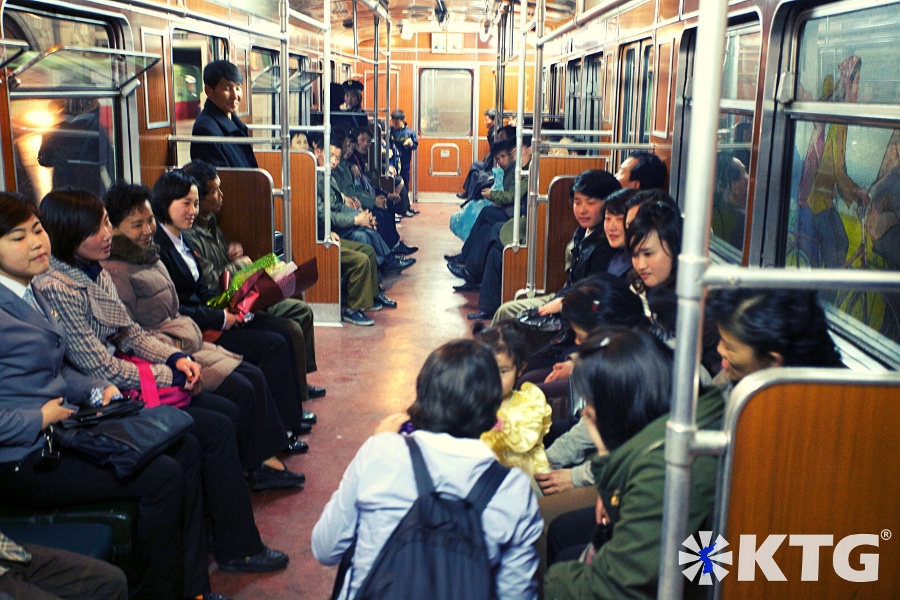
Locals smile as they look at one our travellers showing a curious indlittle girl some pictures she just took of her
Luckily our partners in Pyongyang have allowed us offer extended subway rides these past few years and this has helped us prove that such conspiracy theories are not true. We do recall however, and much to our awe, reputable Western media channels suggesting such theories!
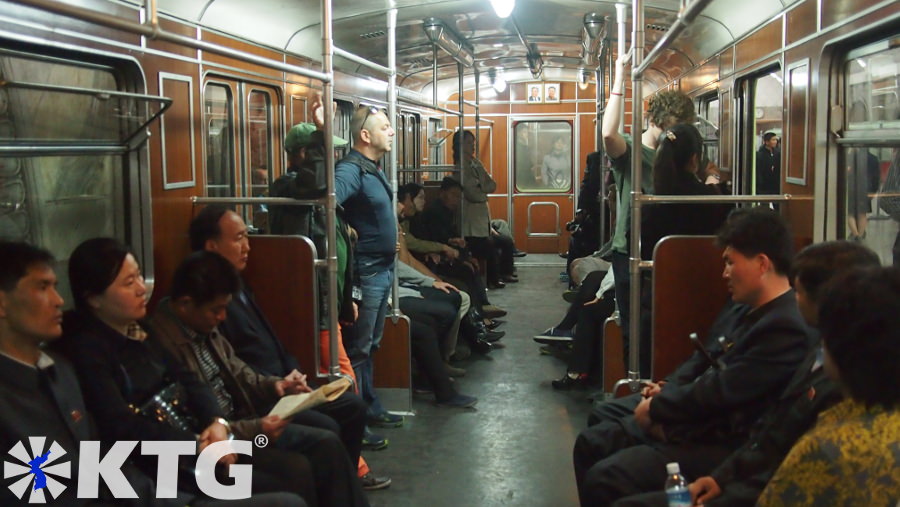
Actors? Travellers sometimes ask us if the people we see at the metro are actors for foreigners to see.
"Well, what about when we see people get off the train at the terminal station and then jump back on the train going in the opposite direction? Surely this is evidence that people there are just actors pretending to go somewhere, why else would they go in the opposite direction?" You might ask yourself as some travellers have asked us before.
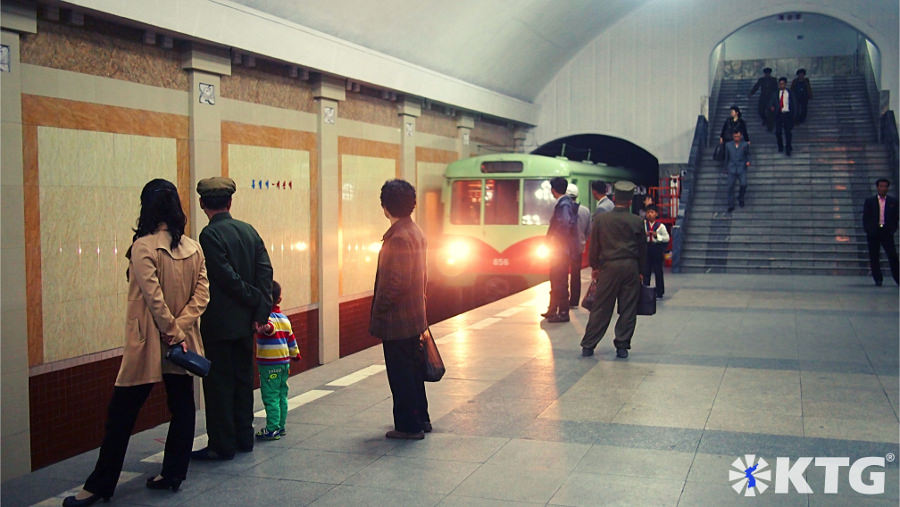
The reason people, usually old people do this, is because they want to secure a seat when taking a long ride. So what they do is take a stop or two to the terminal station and then hop on the first train going the direction they want to go.
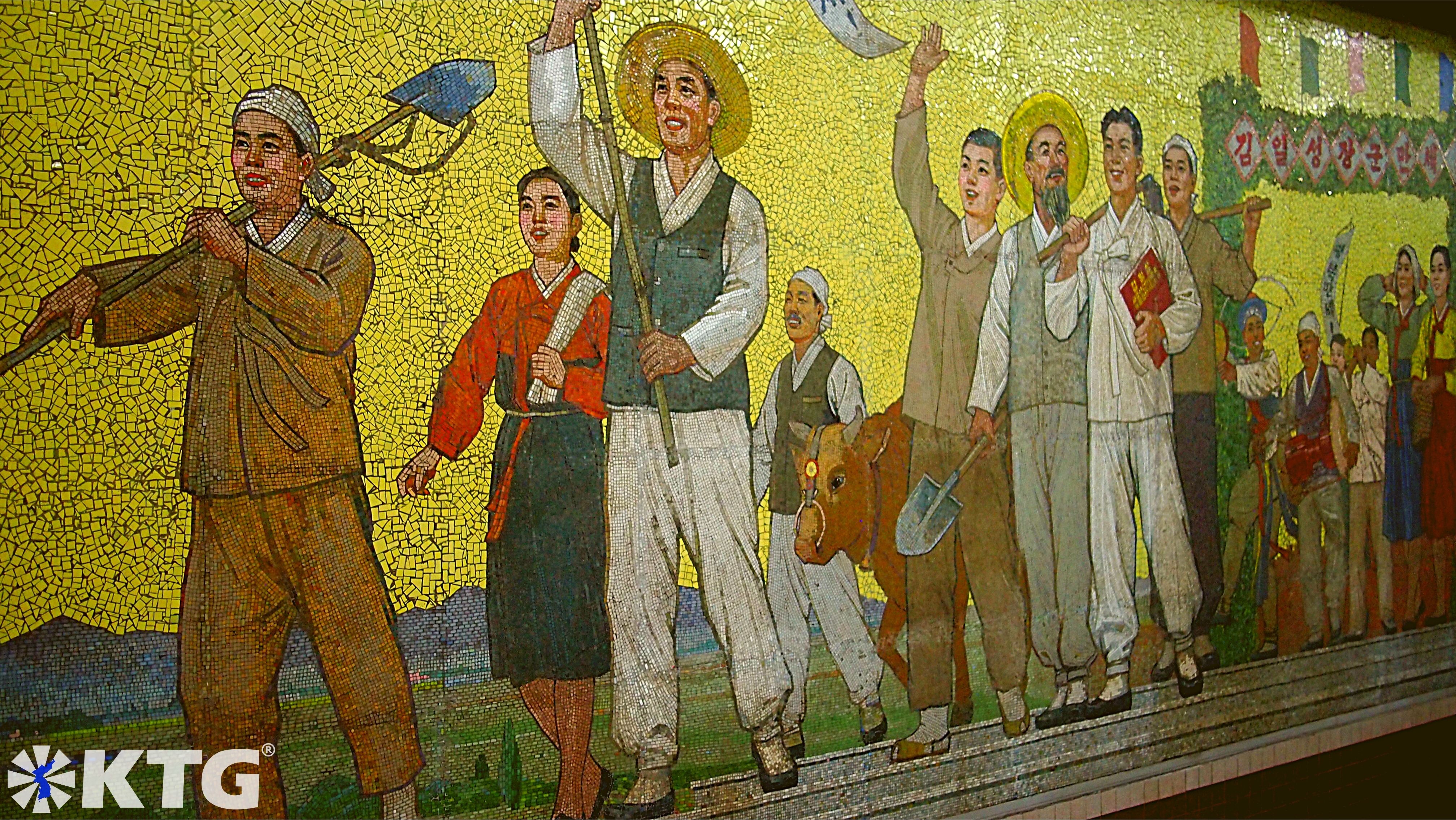
Interaction with locals
The visit to the metro line gives visitors a chance to see and to some extent interact with local people getting along with their daily lives in the North Korean capital.
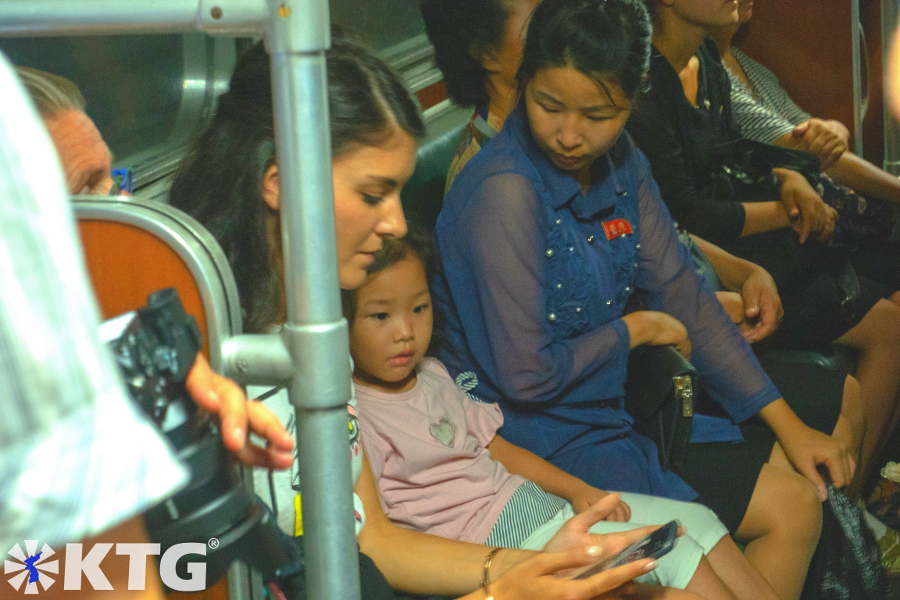
KTG traveller shows a local girl games on her phone
You will also be likely to get some curious looks from the people you encounter, especially children and teenagers. Please note that our group sizes are small and this allows for greater interaction with locals compared with large groups of 20 or 30 people.
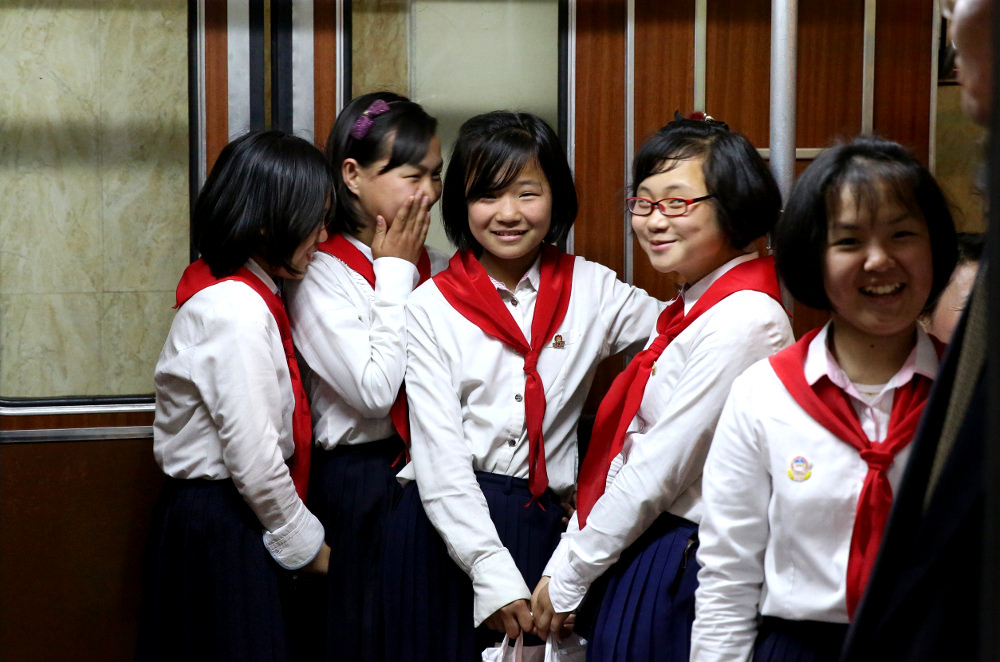
Young Pioneer girls shyly smile at one of our travellers
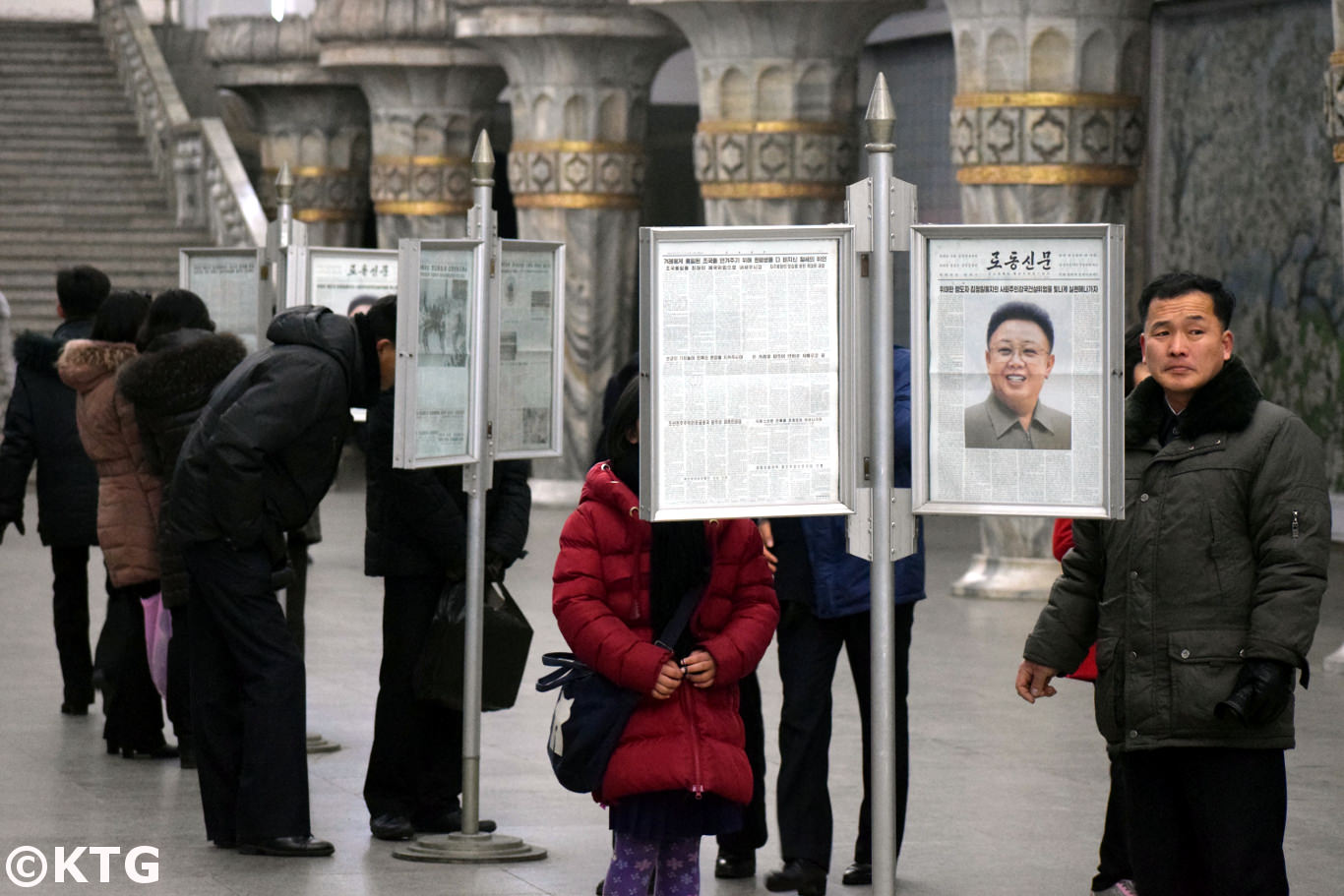
Interesting II: able to read Korean? Then why not read the local newspaper on the station platform which has its pages framed at different posts so that locals can read the latest updates.
Carriages
Interesting: when taking the metro see if you can spot former West German graffiti on some of the carriages' windows!
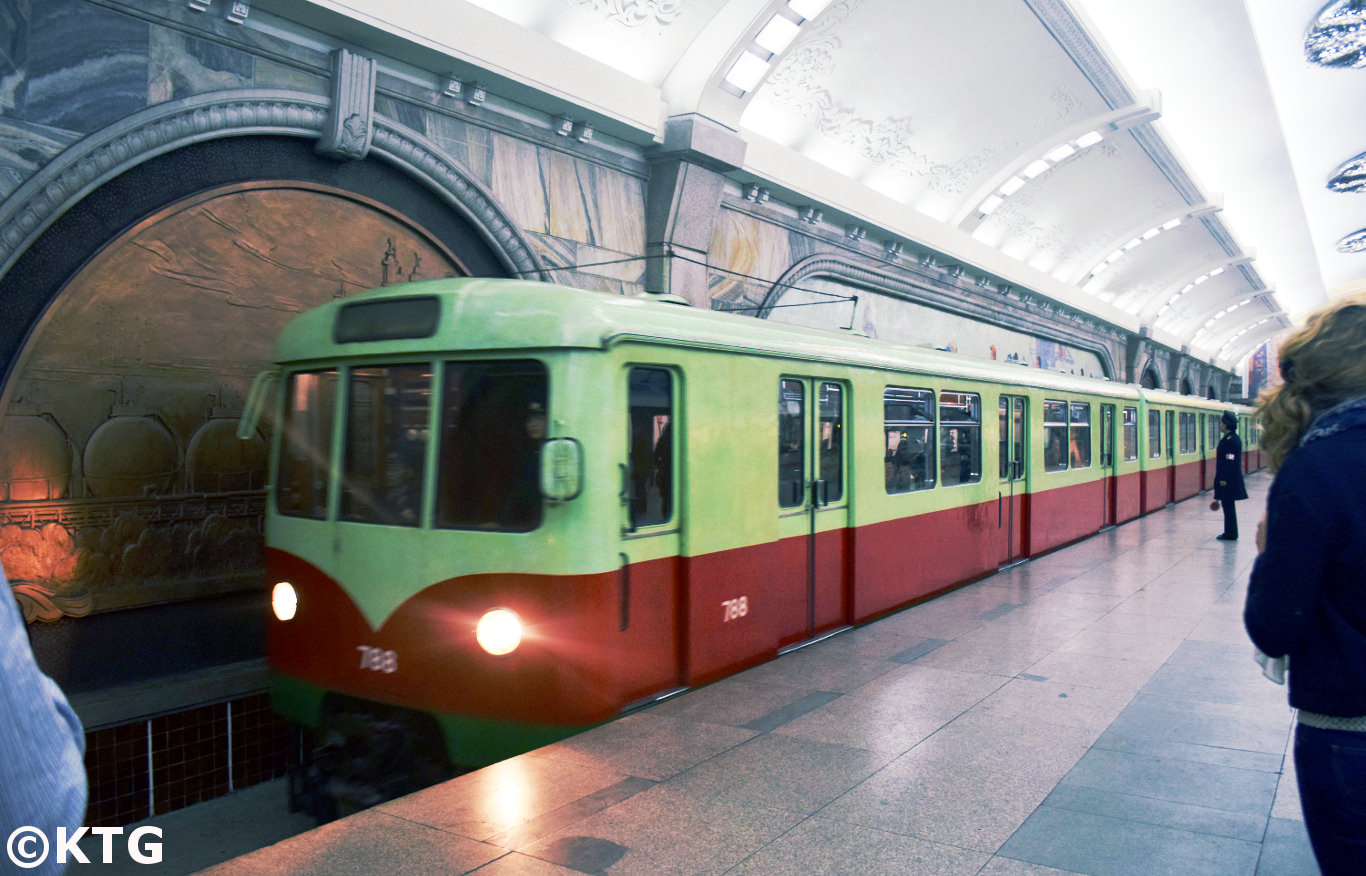
German made carriage
During the 1970s and 1980s the carriages used were from China. However, in 1997 the DPRK bought rolling stock carriages from Berlin.
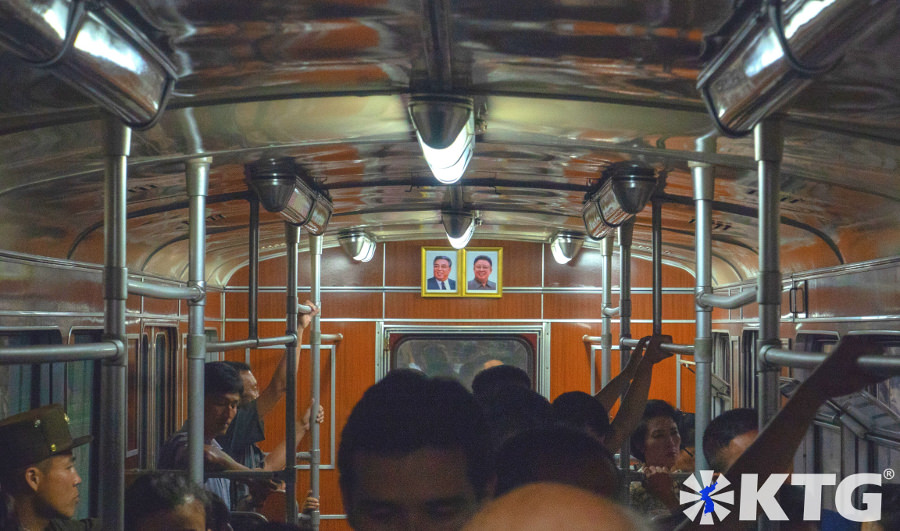
Portraits of President Kim Il Sung and Chairman Kim Jong Il
This included trains from former East and West Berlin. Those used in East Germany are no longer used in the metro system but can be spotted on train tracks in the northern areas of the country. Although the interiors were remodelled, windows were not replaced, hence the German graffiti in Pyongyang!
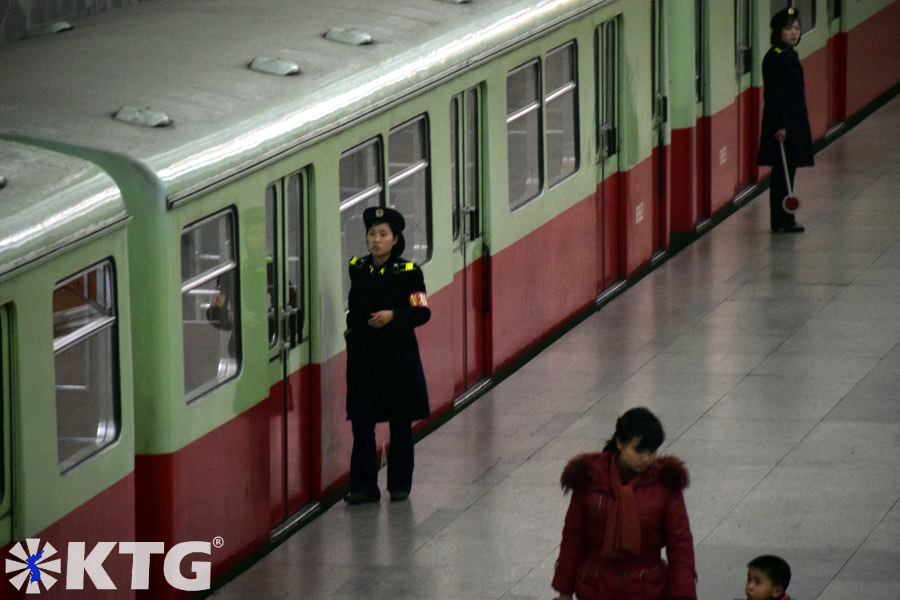
In 2015, the DPRK made their firsts 100% made DPRK metro carriage.
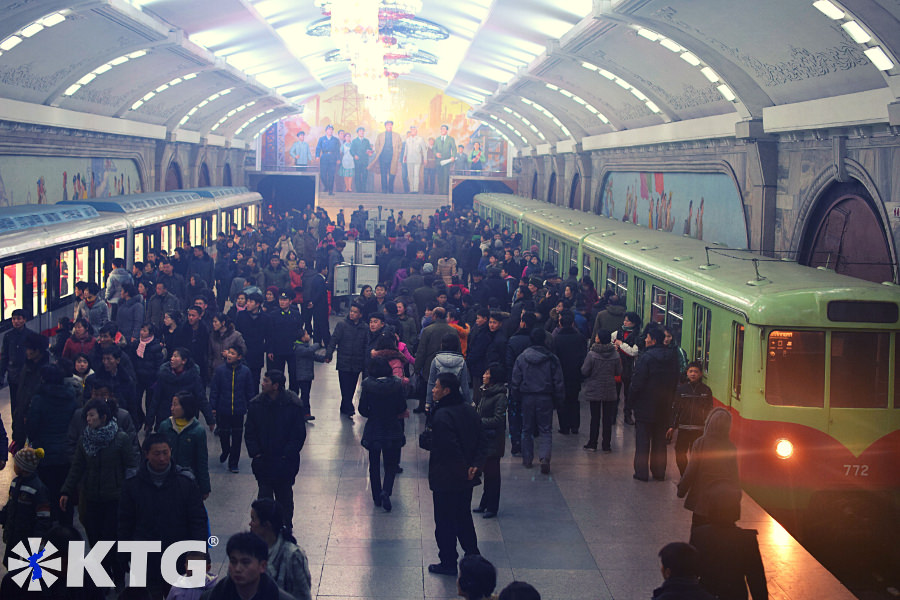
New and Old
Modern, with screens showing cartoons & documentaries, screens with the temperature, air-con and lit route maps.
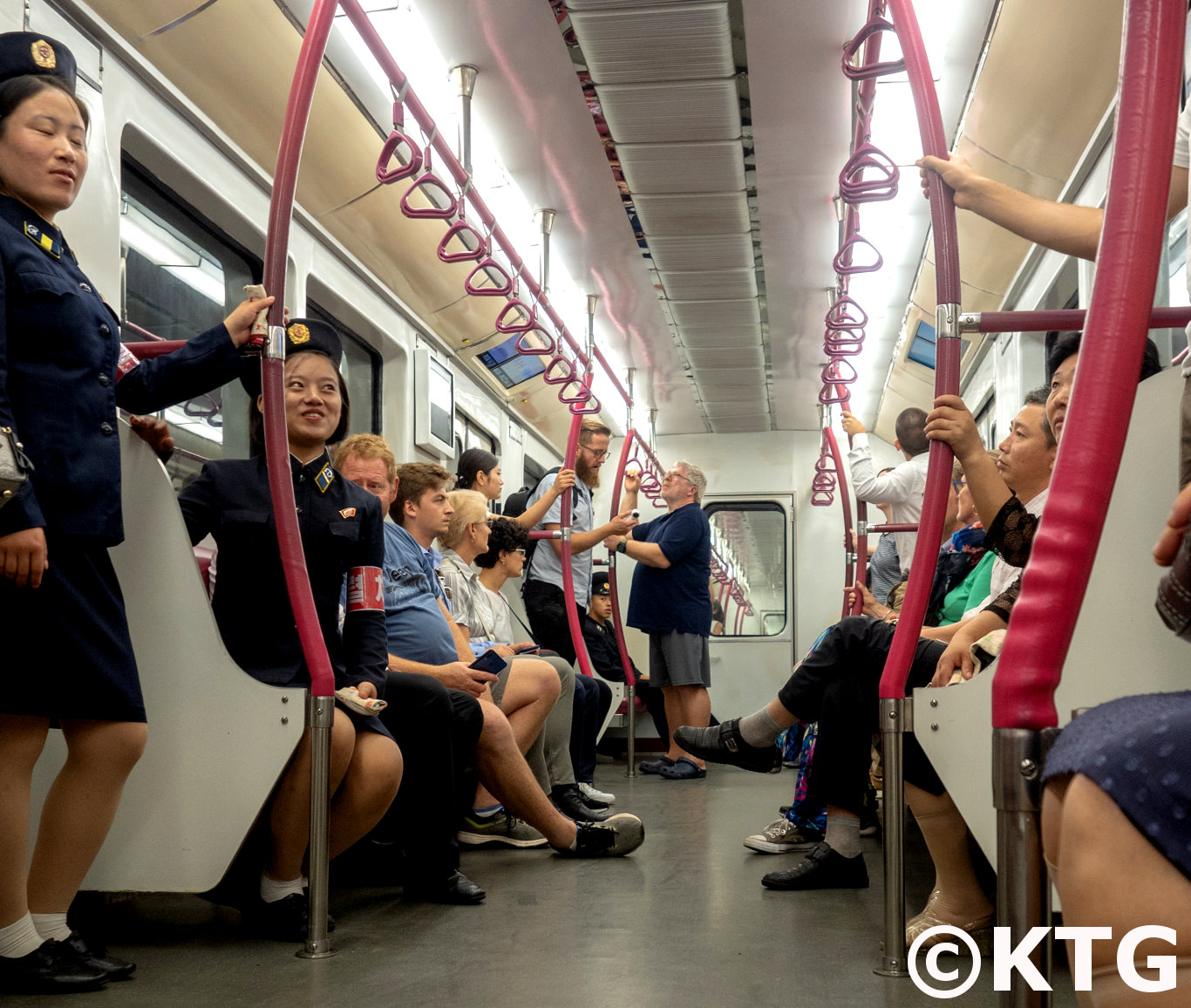
Workers of the Pyongyang metro chatting inside the new train carriage
This train was inaugurated by Leader Kim Jong Un. There is in fact a plaque marking this ride on the train carriage itself. KTG were one of the first groups to take this train, it is not that easy as, at the time of writing, there is only one available. When we first took this train, it was too our Korean guides’ first time. One of our guides, who had lived in Europe, had her face lit up and could not stop smiling. "See how great our country is!" She proudly remarked.
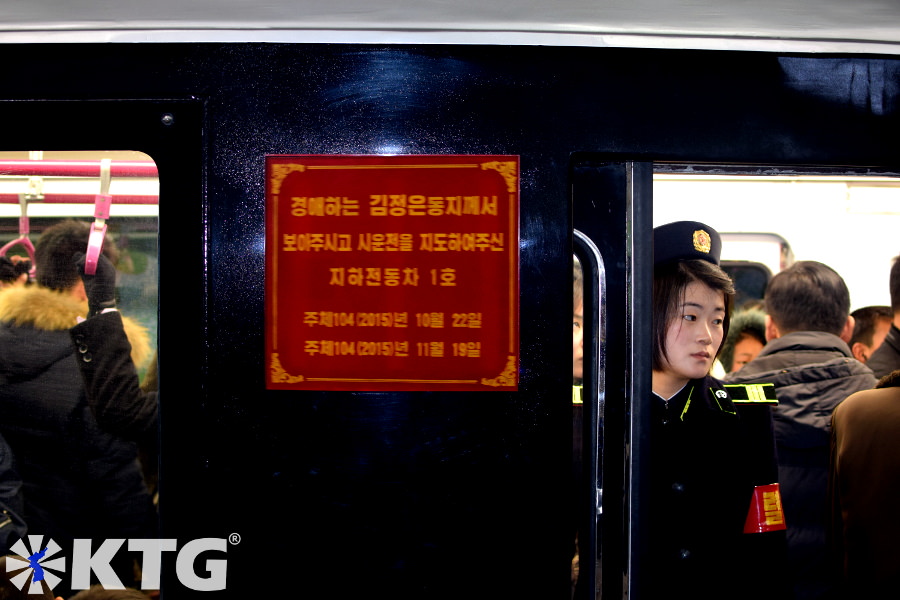
Years are marked in the Juche Year and in A.D.
Pyongyang Metro Logo
지하철 (Ji Ha Chol) is the word for metro in Korean.
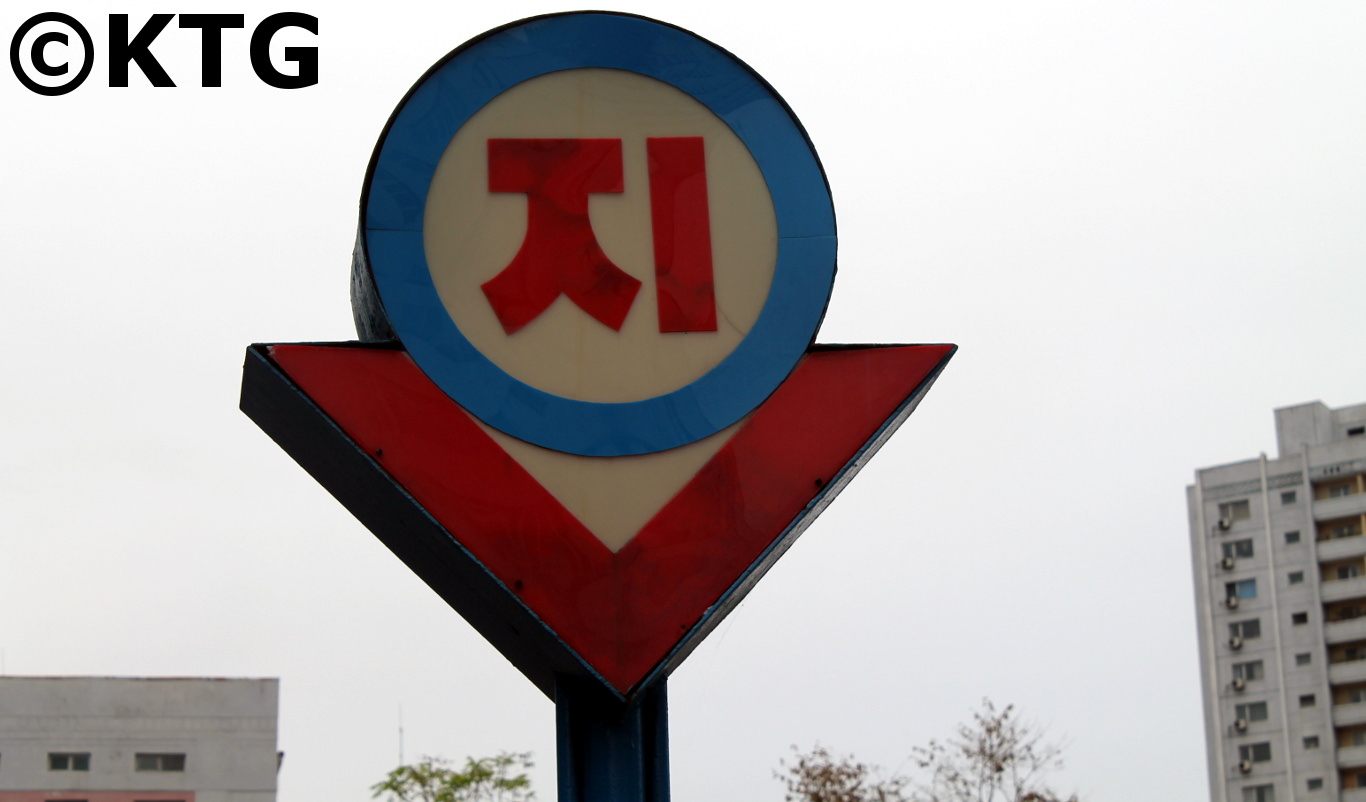
As you can see the, the first word 지 (Ji), is used in the Pyongyang metro’s logo. Want to break down the meaning of Ji Ha Chol? Ji means ground, ha means under and chol means railway (it literally means iron).
Kumsusan Palace of the Sun
The Kumsusan Palace of the Sun is the most sacred place in the DPRK. It used to be called the Kumsusan Assembly Hall and had it’s own subway station. President Kim Il Sung and Chairman Kim Jong Il now lay here in state and the train no longer stops here. It slows down as you ride through the station in sign of respect to the leaders.
Please click on our DPRK guide to see what other places you will be able to visit in North Korea other than the Pyongyang Metro.


















